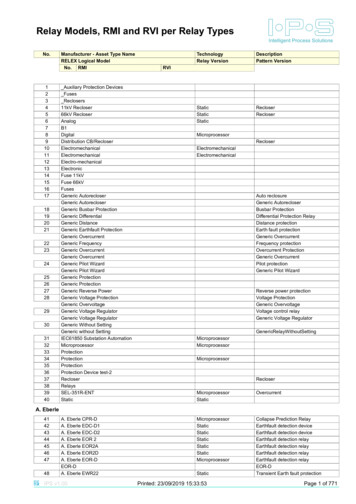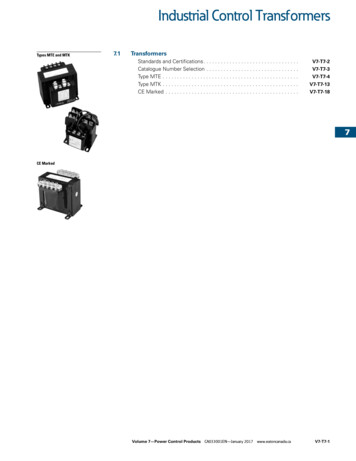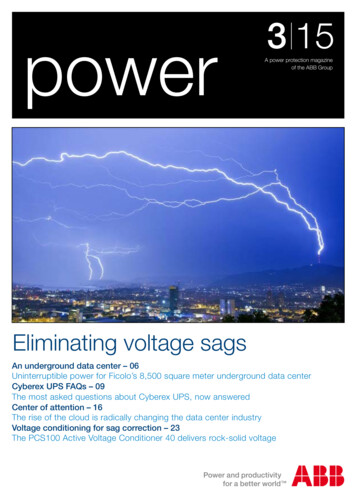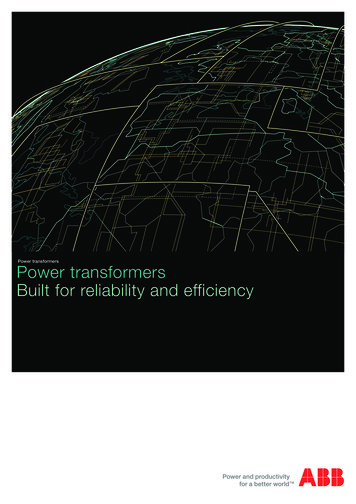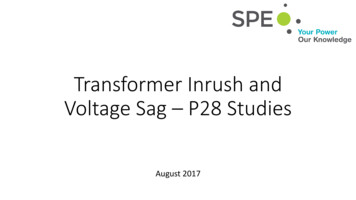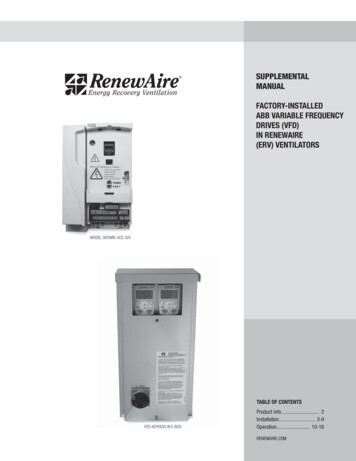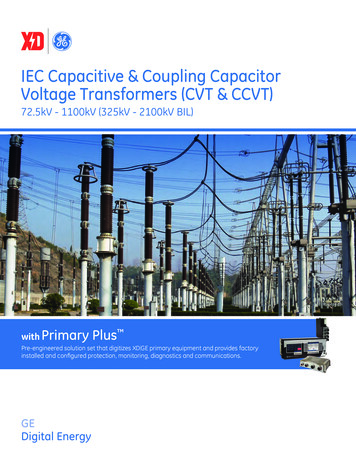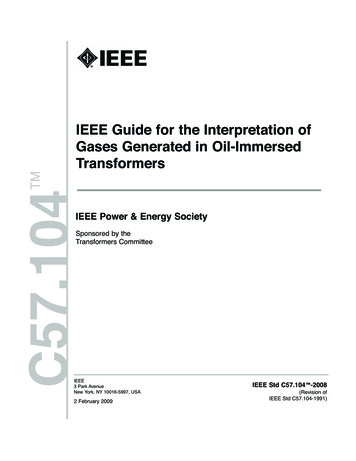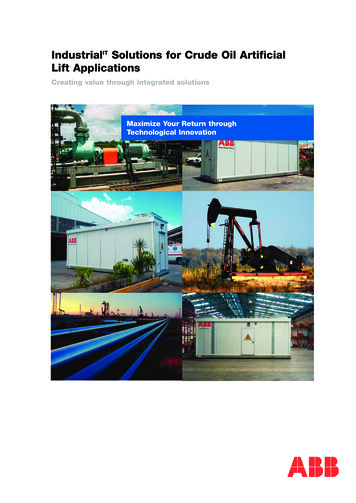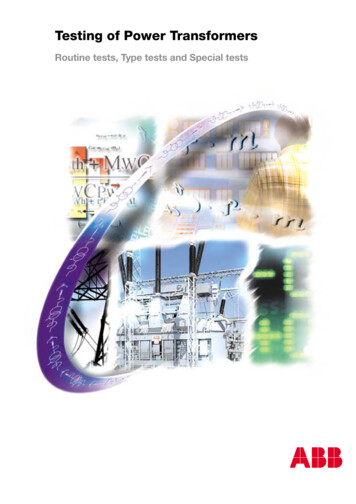
Transcription
Testing of Power TransformersRoutine tests, Type tests and Special tests
Testing ofPower TransformersRoutine tests, Type testsand Special tests
Testing ofPower TransformersRoutine tests, Type testsand Special testsunder participation of CarlsonAkeJitka FuhrGottfried SchemelFranz Wegscheider1st Editionpublished byPRO PRINTforABB Business Area Power TransformersAffolternstrasse 44, 8050 Zürich, SCHWEIZTelefon 41 1317 7126, e-Mail: info@abb.com, www.abb.com
Layout/DesignTypesetting/Reproduction: Pro Print GmbH, DüsseldorfTypeface:Neue HelveticaPrinting:InterDruck, BüllingenPaper:Bilderdruck matt 135 g/qmTesting of Power Transformersunder participation of CarlsonAkeJitka FuhrGottfried SchemelFranz Wegscheider1st Editionpublished by Pro Print GmbH, DüsseldorfISBN 3-00-010400-3 ABB AGAll rights reserved.– 76.00
PrefaceRemember school days? Nothing caused more excitement thanthe teachers’ announcement of a test. Because a test confirmswhat you know, if you can apply in real life what you havelearned in a classroom, under strict, rigorous and controlledconditions. It is a chance to demonstrate excellence.Testing of power transformers seems like a similar experience;and therefore ABB undertook to write this book.Transformer testing has developed considerably over the pastyears. It evolved from the simple go-no-go verdict into asophisticated segment within transformer manufacturing. In thisbook we have laid down important aspects on transformertesting in order to enhance the understanding of the testingprocedures and its outcome.The book represents the collective wisdom of over 100 yearsof testing power transformers. It has been written for transformer designers, test field engineers, inspectors, consultants,academics and those involved in product quality.ABB believes that the knowledge contained in this book willserve to ensure that you receive the best power transformerpossible. The more knowledgeable you are, the better thedecisions you will take.Zürich, October 2003ABB Business Area Power TransformersT E S T I N GO FP O W E RT R A N S F O R M E R S7
Table of Contents88Preface7Table of Contents84.2Purpose of measurement424.3General424.4Measuring the voltage ratio431Introduction134.5Test circuit441.1Why transformer testing?144.6Measuring procedure491.2Types of tests144.7Measuring uncertainty511.3Test sequence15A4Appendix521.4Remarks concerning this test book17A 4.1Determination and localization of errors522Dielectric integrity and its verification1952.1References / Standards20Measuring the short-circuit voltageimpedance and the load loss555.1References / Standards565.2Purpose ot the test565.3General562.2General202.3Voltage appearing during operation212.4Verifying transformer major insulatiionelectrical strength235.4Measuring circuit612.5Test voltages235.5Measuring procedure622.6Test requirements255.6Evaluation of the measuring results65Measuring uncertainty652.7Examples for dielectric routine tests275.7A2Appendix28A5Appendix66A 5.1Interdependence of relativeshort-circuit voltage (or short-circuit voltage)and winding temperature66A 2.1Examples283Measurement of winding resistance313.1References / Standards323.2Purpose of the test323.3General323.4Principle and methodsfor resistance measurement34A 5.2Load loss separation when windingresistances are not known67A 5.3Measuring equipment requirements67A 5.4Instrument error correction69A 5.5Instrument transformer error correction69A 5.6Measuring the short-circuit voltage for startingtransformers having an air gap72A 5.7Connection for investigation tests72A 5.8Examples736Measuring the no-load lossand no-load current796.1References / standards806.2Purpose of measurement806.3General806.4Measuring circuit866.5Measuring procedure893.5Measurement procedure353.6Interpretation of the measured values363.7Examples363.8Uncertainty in resistance measurements36A3Appendix37A 3.1General requirements on equipment37A 3.2Value of the DC-current of measurement38A 3.3Kelvin (Thomson) measuring circuit39A 3.4Examples394Verification of voltage ratio and vectorgroup or phase displacement416.6Evaluation of the measuring results904.1References / Standards426.7Measuring uncertainty91T E S T I N GO FP O W E RT R A N S F O R M E R S
Table of ContentsA6Appendix929.5PD measurement on transformersA 6.1Measuring equipment specification929.6PD measuring procedure126A 6.2Determination of the hysteresisand eddy current loss components9.7Procedure for Investigation of PD sources128929.8Detection of acoustical PD signals133A 6.3Preliminary measurements of the iron core939.9Detailed investigation of the PD source134A 6.4Special measuring circuits949.10Measuring uncertainty139A 6.5Examples95A9Appendix1407Separate source AC withstand voltage testor Applied voltage test1A 9.1Physics of partial discharge14097A 9.2Principle of quasi-integration1437.1References / Standards98A 9.37.2Purpose of the test98True charge, apparent chargeand measureable charge1477.3General98A 9.4Typical external noise sources149Advanced PD system1511237.4Principle and measuring circuit99A 9.57.5Measuring procedure99A 9.6Detection of acoustical PD signals1547.6Measuring Uncertainty100A 9.7A7Appendix101Localization of the PD source using analysisof the electrical signals157A 7.1Calculation of the capacitive loadcompensation requirementsA 9.8Corona shielding16010110General requirements for the measuringequipmentLightning impulse and switchingimpulse test16110210.1References /Standards1628Induced voltage tests10510.2Purpose of the test1628.1References / Standards10610.3General1638.2Purpose of the test10610.4Impulse shape16510.5Test connections16710.6Test procedure / recordings17110.7Assessing the test results and failure detection17410.8Calibration – impulse measuring system /measuring uncertainty175Appendix176A 7.28.3General1068.4Principle and test circuit1078.5Measuring procedure1098.6Measuring uncertainty114A8Appendix115A8.1Calculation of the load for the inducedvoltage test115A 10A 10.1 Waveshape and its assessment176A 10.2 Generation of high impulse voltages177117A 10.3 Pre-calculation of impulse waveform180Correction of the voltage drop acrossthe protective resistance of sphere-gaps118A 10.4 Test circuit parameters for switchingimpulse test183A 10.5 Measuring high impulse voltages1839Partial Discharge Measurements119A 10.6 Calibrating the impulse voltage divider ratio1909.1References /Standards1209.2Purpose of measurement120A 10.7 Use of a Sphere-gap for checking the scalefactor of an impulse peak voltmeter1909.3General120A 10.8 Measuring the impulse current1939.4Principle of PD measurement121A 10.9 Earthing the impulse circuit194A8.2A8.3General requirements for the measuringequipmentT E S T I N GO FP O W E RT R A N S F O R M E R S9
Table of ContentsA 10.10 Switching impulse wave form195A 10.11 Air withstand196A 10.12 Impulse voltage stress on power transformers19611199Temperature rise test12.1Measurement of zero-sequenceimpedance(s) on three-phase transformers225Refernces / Standards22612.2Purpose of measurement22612.3General22612.4Definition of the zero-sequence impedance22712.5Measuring procedure228Appendix23011.1References /Standards20011.2Purpose of the test20011.3Temperature / temperature rise20011.4Temperature measurements201A 1211.5Principle and test methods201A 12.1 Example for an unbalanced three-phase system 23011.6Measurement circuit and procedure203A 12.2 Types of zero-sequence impedance23011.7Hot spot temperatures20911.8Practical examples and analysisof the measured valuesA 12.3 Influence of winding connection andtransformer design231210A 12.4 Examples and interpretation23411.9Measuring uncertainty21013Short-circuit withstand test237A 11Appendix21113.1References /Standards238A 11.1 Definitions, temperature and temperature-rise21113.2Purpose of the test238A 11.2 Other test methods for temperature rise test21213.3General238A 11.3 Estimating the duration of the temperaturerise test [2]13.4213Test conditions, testing techniques andtest connections239A 11.4 Graphical extrapolation to ultimatetemperature [2]214Appendix244A 11.5 Oil temperature measurement bymeasuring the surface temperature [61]A 11.6 Correction of the injected currentwith non-nominal frequency214214A 11.7 Correction factors according toIEEC Std.C57.12.90 [51]1012215215A 11.9 Practical examples and analysisof the measured values216O FP O W E RA 13.1 The difference between post-establishedand pre-established short-circuit [105]244A 13.2 Examples for single-phase test connectionssimulating the three-phase test244A 13.3 The calculation of the symmetrical short-circuitcurrent according to IEC 60076-5 [5]245A 13.4 The calculation of the symmetrical short-circuit246current Isc according to C57.12.00 [50]A 11.8 Conformance of the measured averagewinding temperature rise with the realwinding temperature rise in operationT E S T I N GA 13A 13.5 Low-voltage recurrent-surgeoscilloscope methodT R A N S F O R M E R S246
Table of Contents14Sound level measurement24717Measurement of insulation resistance27114.1References /Standards24817.1References / Standards27214.2Purpose of measurement24817.2Purpose of the measurement272General272The measuring circuit /The measuring procedure [51]27314.3General [7], [51], [106]24817.314.4Measurement and measuring circuit24917.414.5Measuring procedure25014.5Measuring uncertainties254A 17Appendix274A 14Appendix25518Measurement of dissipation factor (tanδ)of the insulation system capacitances275A 14.1 Human perception of sound [106]255A 14.2 Estimating load-sound power level,and the influence of the load [7]18.1References / Standards27625518.2Purpose of the measurement276A 14.3 Addition of no-load sound and load sound [7]25618.3General276A 14.4 Definitions [7]25618.4A 14.5 Calculation of the environmentalcorrection factor K [51]The measuring circuit /The measuring procedure [51]258A 14.6 The calculation of sound power level, example259A 18 AppendixA 18.1 ExamplesA 14.7 Far-field calculations26015277280280Index283References / Bibliography289Standards290Test on on-load tap-changers anddielectric tests on auxiliary equipment26115.1References / Standards26215.2Purpose of the test / General26215.3Test procedure [1] / Test circuit262International Electrotechnical Commission (IEC) 29015.4Test of auxiliary equipment [3], [50]263IEEE / ANSI Standards29116Measurements of the harmonicsof the no-load currentBooks291265Technical Reviews29216.1References / Standards266Editors29316.2Purpose of measurement26616.3General26616.4The measuring circuit [100]26716.5The measuring procedure26715.6Examples267A 16Appendix268A 16.1 The relationship between flux density, no-loadcurrent and harmonic content. [106]268A 16.2 Example268Explanation to the vocabularyThe authors vocabulary in the test book is based on IEC Standards.There are no really important differences between the vocabularyapplied in IEC and IEEE (ANSI) Standards.The only exception is the use of the words „earth“/“earthed“(according to IEC) and „ground“/“grounded“ (according to IEEE).T E S T I N GO FP O W E RT R A N S F O R M E R S11
1. IntroductionTesting ofPower Transformers1. IntroductionT E S T I N GO FP O W E RT R A N S F O R M E R S13
1. Introduction1.1Why transformer testing?Tests serve as an indication of the extent to which a transformeris able to comply with a customer’s specified requirements;for example: Loading capability Dielectric withstand Further operating characteristicsTests are also part of a manufacturer’s internal quality assuranceprogram. A manufacturer’s own criteria have to be fulfilled inaddition to requirements specified by customers and applicablestandards.Differing requirements are generally combined and published innational and international standards. The primary StandardsOrganizations are IEC and ANSI. These standards are often useddirectly to develop national standards. IEC is the abbreviation forInternational Electro-technical Commission and ANSI stands forAmerican National Standard Institute, Inc.In the electric area, ANSI has to a great extent delegated thewriting and publication of standards to IEEE, the Institute ofelectric and Electronics Engineers, Inc.The IEC and IEEE Standards specify the respective tests thatverify compliance with the above requirements; e.g.:Temperature rise tests to verify loading capability,see section 11Dielectric tests to demonstrate the integrity of the transformerwhen subjected to dielectric stresses and possible overvoltages during normal operation, see section 2.No-load and load loss measurements, short-circuitimpedance measurements, etc. to verify other operatingcharacteristics.1.2Types of testsThe IEC 60076-1 [1] and IEEE Std C57.12.00 [50] Standardsdistinguish between the following types of tests: Routine tests Type- or design1 tests Special- or other1 tests14T E S T I N GO FP O W E RT R A N S F O R M E R S
1. IntroductionRoutine testsRoutine tests are tests required for each individual transformer.Typical examples:Resistance measurements, voltage ratio, loss measurements, etc.Type- or design testsType or design1 tests are conducted on a transformer which isrepresentative2 of other transformers, to demonstrate that thesetransformers comply with specified requirements not covered byroutine tests.Typical example:Temperature rise test.Special- or other testsSpecial- or other1 tests are tests other than type- or routine testsagreed to by the manufacturer and the purchaser.Typical example:Measurement of zero-sequence impedance, sound levelmeasurement, etc.1Term used in the IEEE Standards [50], [51]2“Representative” means identical in rating and construction, buttransformers with minor deviations in rating and other characteristicsmay also be considered to be representative [1].Note:Depending on the respective standard and the maximumsystem voltage, certain dielectric tests, such as lightningimpulse tests, for example, may either be routine tests,type tests or special tests, (see section 2, table 1 and 2).The same is true for switching impulse tests.1.3Test sequenceAs the Standards do not lay down the complete test sequencein an obligatory basis, it is often the source of long discussionsbetween customer and manufacturer.On the other hand the test sequence for dielectric tests isgenerally fixed in IEC and IEEE Standards.Following all existing standard regulations and recommendationsconcerning this matter followed by recommendations of theauthors, see section 1.3.3.T E S T I N GO FP O W E RT R A N S F O R M E R S15
1. Introduction1.3.1IEC StandardsIEC 60076-3 (2000) [3], clause 7.3“The dielectric tests shall, where applicable and not otherwiseagreed upon, be performed in the sequence as given below:-Switching impulse test-Lightning impulse test (line terminals)-Lightning impulse test (neutral terminal)-Separate source AC withstand test (Applied voltage test)-Short-duration induced AC withstand voltage test includingpartial discharge measurement-Long-duration induced AC voltage test including partialdischarge measurement”This test sequence is in principle obligatory; but allows otheragreements between customer and manufacturer.IEC 60076-1 (2000) [1], clause 10.5“In deciding the place of the no-load test in the complete testsequence, it should be borne in mind that no-load measurementsperformed before impulse tests and/or temperature rise tests are,in general, representative of the average loss level over long timein service. Measurements after other tests sometimes show highervalues caused by spitting between laminate edges during impulsetest, etc. Such measurements may be less representative of lossesin service”.This test sequence is a recommendation and not obligatory.1.3.2IEEE StandardsIEEE Std C57.12.90 [51], clause 4.3“To minimize potential damage to the transformer during testing,the resistance, polarity, phase relation, ratio, no-load loss andexcitation current, impedance, and load loss test (and temperaturerise tests, when applicable) should precede dielectric tests. Usingthis sequence, the beginning tests involve voltages and currents,which are usually reduced as compared to rated values, thustending to minimize damaging effects to the transformer.”Also this test sequence is recommendation and not obligatory.IEEE Std C57.12.90 [51], clause 10.1.5.1“Lightning impulse voltage tests, when required, shall precedethe low-frequency tests. Switching impulse voltage tests, whenrequired, shall also precede the low-frequency tests.For class II power transformers, the final dielectric test to beperformed shall be the induced voltage test.”This test sequence is obligatory.16T E S T I N GO FP O W E RT R A N S F O R M E R S
1. Introduction1.3.3Recommendation of the authorsTaking into account all IEC- and IEEE regulations andrecommendations and based on their own experiencethe authors propose the following test sequence: Ratio, polarity and phase displacement Resistance measurement No-load test (followed, if specified, by the sound level test) Load loss and impedance Zero-sequence impedance test (if specified) Dielectric tests:-Switching impulse (when required)-Lightning impulse test (when required)-Separate source AC voltage test-Induced voltage test including partial discharge test.The test sequence of the tests preceding the dielectric test canbe slightly changed due to test field loading or other operationalreasons.1.4Remarks concerning this test bookThis test book has an initial chapter covering dielectric integrityin general (section 2), since verification of dielectric integrity isthe result of different types of successful dielectric tests. The firstchapter is then followed by descriptions of each individual test.The individual tests and measurements are covered in greaterdetail in the following sections (sections 3 to 18): Measurement of winding resistance (R), section 3. Measurement of voltage ratio and vector group(phase displacement) (R), section 4. Measurement of impedances and load losses (R), section 5. Measurement of no-load loss and no-load current (R),section 6. Separate source AC withstand voltage test (R), section 7. Induced voltage test (R alternatively also S), section 8. Partial discharge test (R alternatively also S), section 9. Impulse test (R and T ), section 10. Temperature rise test (T ), section 11.T E S T I N GO FP O W E RT R A N S F O R M E R S17
1. Introduction Measurement of zero-sequence impedances (S), section 12. Short circuit withstand test (S), section 13. Sound level measurement (S), section 14. Test on on-load tap-changers and dielectric tests on auxiliaryequipment (R), section 15. Measurements of the harmonics of the no-load current (S),section 16. Measurement of insulation resistance (S), section 17. Measurement of the dissipation factor (tan δ ) of the insulationcapacitances or insulation power-factor tests (S), section 18.Note:R Routine testT Type testS Special testThe individual test items may be interwoven and carried out aspart of a combined average to verify certain characteristics, suchas resistance measurement.Several aspects have been considered regarding the tests andtest procedures, such as: Purpose of the test and what is to be achieved bya specific test. Means of generating the supply voltage and current forthe test. Means to measure or indicate the test object response. Means to verify the integrity of the test object. Means to verify presence or absence of damage causedby a specific test.Symbols and abbreviations in this test book follow presentIEC Standards where applicable.18T E S T I N GO FP O W E RT R A N S F O R M E R S
A 14.2 Estimating load-sound power level, and the influence of the load [7] 255 A 14.3 Addition of no-load sound and load sound [7] 256 A 14.4 Definitions [7] 256 A 14.5 Calculation of the environmental correction factor K [51] 258 A 14.6 The calculation of sound power level, example 259 A 14.7 Far-field calculations 260 15 Test on on-load tap .
